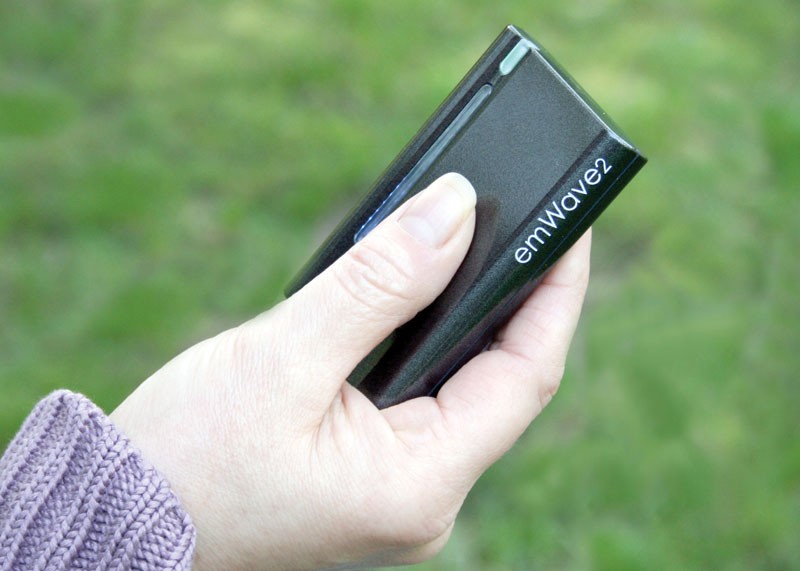What causes you to feel anxiety or pressure, worried or burdened? What stresses you out? If you said: “Nothing,” then you’re in the lucky 60 percent of Americans who, according to a recent Gallup poll, don’t feel overly stressed.
But maybe you’re one of the 40 percent — that is, more than 124 million Americans — who do feel stressed. At least you’re not alone. But what do you do about it?
You could just chalk it up to an unavoidable part of your lifestyle. Or you could hook yourself up to a device that will help your body learn to deal with that stress more effectively.
For years, people have practiced managing the body’s reactions to stress through biofeedback in a medical office. But now, the concept that’s been around for half a century is finally coming home. Or to your work. Or just about anyplace. Portable devices now make it possible to access the benefits of biofeedback using a device about the size of a deck of cards or through sensors that connect to your computer.
NEW TECHNOLOGY
The basic premise of biofeedback is “that the mind and body are connected, and that people can be taught to harness the power of this connection to change physical activity and improve health and function,” according to the Association for Applied Psychophysiology and Biofeedback.
Donald Shearn first showed, in 1962, how it was possible for people to volitionally increase their heart rates. (In the experiments, his subjects were highly motivated: they learned to change their heart rates so they could avoid receiving an electric shock.) Today, sports stars, migraine sufferers, stay-at-home moms, people with autism — all sorts of folks — use biofeedback to improve their health or performance.
Dr. Myron Thurber, founder of Spokane’s Neurotherapy Northwest, says biofeedback is actually quite simple. He compares it to standing in front of a mirror and combing your hair.
“I can change my hair if I stand in front of a mirror. I’m aware of what I look like, and I can do something about it,” says Thurber. “Biofeedback is about becoming aware of some of the processes of our body — heart rate, breathing, for example. When we actually look at something that shows us what our heart patterns are putting out, we [can then] use it to then modify what that otherwise unconscious process is.”
One of the more popular portable biofeedback units is the IOM offered by Wild Divine. It consists of three finger sensors that allow the user to be connected to a computer’s USB port. The company has a variety of software to coordinate with the sensors. There are guided meditation and relaxation techniques led by wellness gurus including Deepak Chopra, Andrew Weil and Dean Ornish to help users learn to relax, as well as games to challenge users to develop ever more control of body functions.
For even more portability, though, a company called HeartMath produces a device called the emWave 2 that allows the user to place a thumb on a sensor pad or clip a sensor on the ear lobe. The device can be used with or without a computer. It measures your pulse and then a “breathing pacer” synchronizes to the user’s “heart rhythms” and the device shows an LED readout that allows the user to breathe along with the breathing pacer. The user is instructed on how to perform a 60-second focusing process to allow heart rate and breathing levels to become optimal.
A HIGHLY EFFECTIVE STATE
Whatever the device used, Thurber says biofeedback can help a person get to that state of “coherence” — where everything fits together psychologically and physiologically. “It’s a highly effective state,” he says. “It’s that moment when everything fits together, when it’s almost effortless. For a golfer, it’s that swing when a ball flies off perfectly. It’s like when Michael Jordan couldn’t miss a shot. It’s the idea of being in a ‘flow.’”
While Thurber has made his living using biofeedback, along with other counseling methods, to treat patients, he welcomes this portable, digital approach to self-help.
“In our society, if, within a couple of minutes, someone can see and feel a change and they can see it on a screen, then I don’t have to convince them,” says Dr. Thurber. “It makes things go faster and easier.”
By becoming adept at managing the body’s responses through practicing biofeedback, it’s possible to lessen the negative impact that everyday stress can have on the body. “What I want the person to be able to do,” says Thurber, “is be in the middle of traffic in L.A., or be in the grocery store line and they forgot their wallet and there’s 15 people behind them. And in five to 10 seconds, they shift from stress and ‘I don’t know what to do,’ to get into that state where they know what to do.”
















